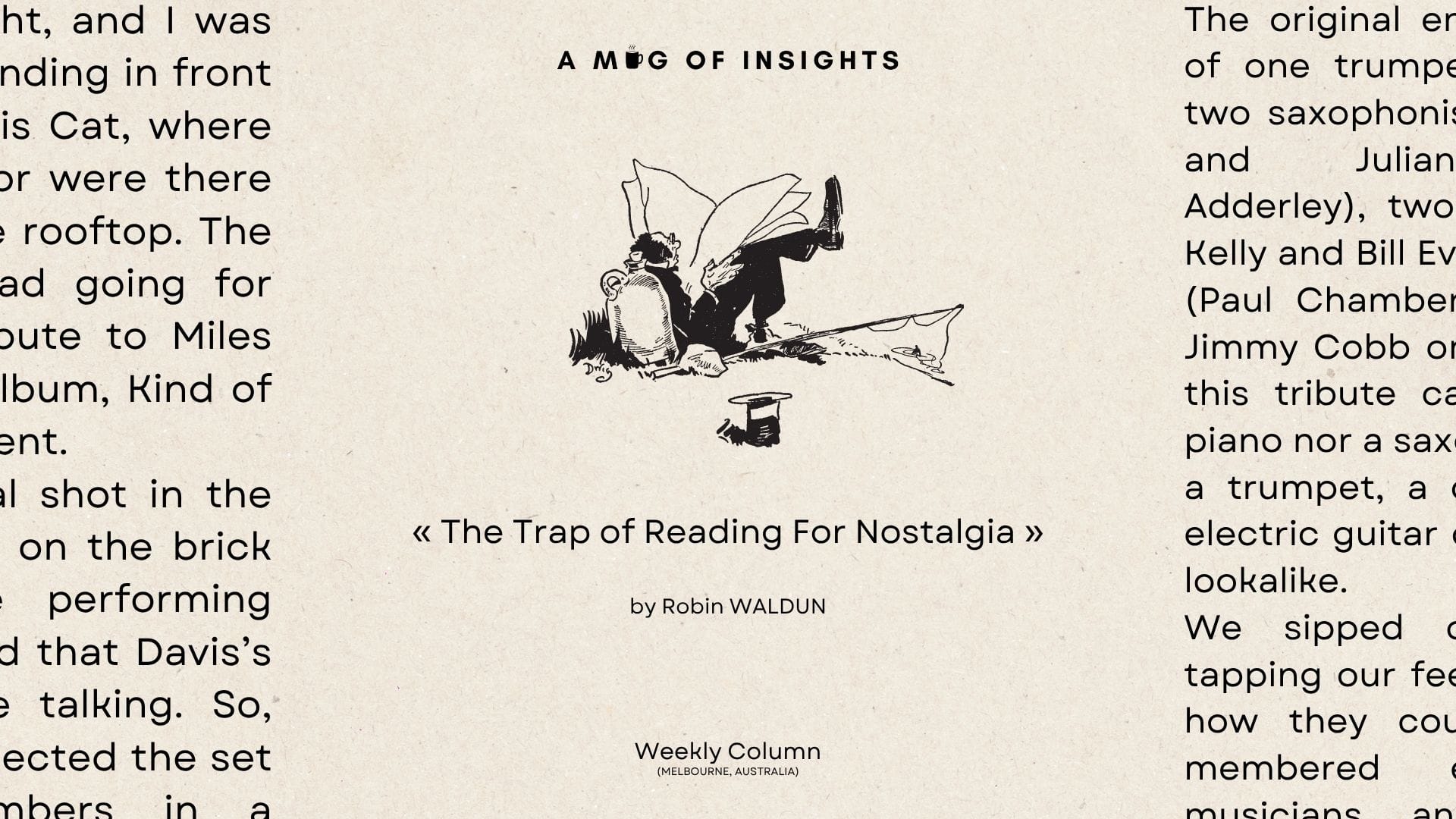The Trap of Reading For Nostalgia

Welcome to the weekly column from A Mug of Insights! From now on, I'll dispatch these letters on Saturdays, and paid subscribers will receive their 1-2-Read letters on Mondays. If you like what you're reading, consider upgrading to the Grande tier for journal prompts and a practical exercise every week to strengthen your reading muscles! Thank you for reading, and I look forward to seeing you next week.
This was a Saturday night, and I was with my friend Hano, standing in front of a jazz bar named Paris Cat, where no one spoke French, nor were there any cats perched on the rooftop. The only thing that they had going for them was a special tribute to Miles Davis’s legendary 1959 album, Kind of Blue, in the club’s basement.
The booking was a total shot in the dark. The show’s poster on the brick wall didn’t name the performing musicians, as they hoped that Davis’s mystique would do the talking. So, naturally, Hano and I expected the set to play all the numbers in a chronological order, from ‘So What’ to ‘Flamenco Sketches’ while being totally faithful to the original.
But as soon as we crammed onto a tiny round table shared with two other patrons, a Kurt-Cobain-looking guy in a navy jacket and tight 2010s-cut chinos rocked up to the stage with an electric guitar. Hano looked at me, and I looked at him, and he knew that I knew that he knew there was no electric guitar in the original ensemble.
The original ensemble consisted of one trumpeter (Miles Davis), two saxophonists (John Coltrane and Julian "Cannonball" Adderley), two pianists (Wynton Kelly and Bill Evans), and a bassist (Paul Chambers), all backed by Jimmy Cobb on drums. However, this tribute cast had neither a piano nor a saxophone. There was a trumpet, a drummer and the electric guitar of our Kurt Cobain lookalike.
We sipped our drinks while tapping our feet, trying to gauge how they could pull off a 7-membered effort with 3 musicians and half of the instruments. But as soon as they started playing, all the worries flew out of the basement. Even without the piano and the saxophones, the electric guitar filled in the blanks, rendering tunes that sounded nothing like the original numbers, yet retained Davis’s DNA. Moreover, while the original prized Davis’s trumpet and Coltrane’s improvisations, this version foregrounded the electric guitar as it took up a majority of the solos, sometimes overshadowing the trumpet player’s reserved and delicate melody.
Now, the purists might jump on a stool in protest, lampooning the guitarist for taking too much ‘artistic liberty’. But for me, this set was like a brilliant cover of a song you adore. While it is not a replica of the original, it opens up new ways to appreciate a familiar melody. Yes, it’s tempting to judge every cover with the standards of a frozen-in-time masterpiece, but there is also joy in seeing how new forms, new musicians and new instruments come to defrost a once canonical piece, liberating it from the shackles of nostalgia.
The same defrosting also happens in literature. When I first set foot on campus, carrying crumpled copies of Camus’s The Stranger and Austen’s Persuasion, I thought my task was to treat these books as pristine unities, despite my copies’ dogged appearances. But the more I read, the more I saw the messy task of enjoying literature.
Brian Dillon captured this beautifully in his book, Essayism, where he writes:
“[Literary works], ancient or modern, can seem precious in their self-presentation, like things too well made ever to be handled.”
Granted, there is a unity in what we now call masterpieces. A great novel sometimes gives us the feeling that we’re walking along the edges of its sprawling web, circling closer and closer to the centre of the text as we reach the epilogue. In fact, the very word: text derives from the Latin root textus, denoting a woven structure that’s held together by the threads of words.
But if we’re not careful, the web can tangle and paralyse us from going deeper. We get distracted by academics’ comments on the author’s alleged perfect style, voice, descriptions, rhetoric, cadence, rhymes, while missing the core of any pleasurable story: feeling into the narrative. The best books I’ve read had to come alive first before I could even think about the technical aspects of their writing. In Dillon’s words:
“Touch them however and they are likely to come alive with the sedimented evidence of years; a constellation of glittering motes surrounds the supposedly solid thing, and [literature] reveals itself to have been less compact and smooth than thought…”
In schools, we were never trained to do this. No teacher ever taught us how to dive into the story, and our eyes are constantly fixed on the dry, analytical anatomy of narratives. We draw them apart, write about them and categorise them until there’s nothing left to enjoy. Then, after graduation, we carry this attitude to everything we read while assuming the art of reading is just that: dry and uninspiring drills.
But this can’t be further from the truth. Even in great works, there are unsolicited tangents, useless dialogue, weird tense shifts and descriptions that seem off. Yet, all these crooked edges sometimes add to the story and reveal the humanity between the lines. No book is perfect, and we have to stop searching for the solid and immovable. And the minute we stop treating reading literature as hard-won battles against difficult prose is also the moment when a book goes from a stiff, consecrated classic frozen between hardcovers to a life-changing afternoon where we can’t stop thinking about the new emotions, colours and voices the book evokes.
Until next week
Robin
Subscribe to my newsletter to get the latest updates and news

Member discussion